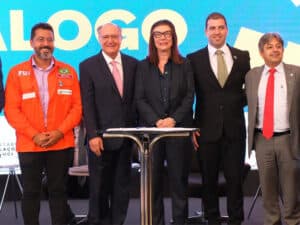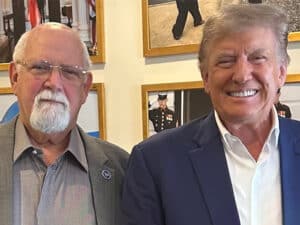
GL North American Committee meets in Houston
Written by Nick Blenkey OCTOBER 15, 2012 — The introduction of sulfur limits in the North American ECA and the ratification of the Maritime Labor Convention 2006 (MLC 2006) were high on the agenda when Germanischer Lloyd’s (GL) North American Committee met at the Houstonian Hotel Delta in Houston recently. The Committee, which was inaugurated in 2010, is made up of representatives from Canadian and American shipowners and operators, shipyards, maritime consultants, and other industry stakeholders, alongside delegates from GL.
OCTOBER 15, 2012 — The introduction of sulfur limits in the North American ECA and the ratification of the Maritime Labor Convention 2006 (MLC 2006) were high on the agenda when Germanischer Lloyd’s (GL) North American Committee met at the Houstonian Hotel Delta in Houston recently. The Committee, which was inaugurated in 2010, is made up of representatives from Canadian and American shipowners and operators, shipyards, maritime consultants, and other industry stakeholders, alongside delegates from GL.
Germanischer Lloyd’s Executive Vice President for the Americas, Uwe Bullwinkel, said the GL Group had broadened its focus in recent years and taken advantage of the integration of new business units to expand its range of services, he said. A programme of growth and targeted acquisitions had transformed the GL Group into a global service provider, especially in the offshore industry, where complementary competencies within the Group’s three business units – Maritime, Oil and Gas and Renewables – meant that contributions were made to projects on multiple fronts, with cable laying and installation, offshore wind farms and wind turbine installation vessels, being notable examples.
Mr Ryan Bishop, GL’s new Area Manager for North America, introduced the topics of the day and followed up with a detailed examination of the GL’s activities in the region. He looked at some of the focus points for GL in the area over 2013 and 2013, especially the use of LNG as a ship fuel, which was increasing of interest to shipowners in light of the ECA introduction, he said, and was an area where GL has considerable experience, having undertaken many projects over recent years, including research on bunkering technologies and port logistics, cost studies for container vessels, overseeing the first conversion of a vessel in service and approval in principle of new designs.
The Maritime Labor Convention 2006 (MLC 2006) will bring sweeping changes to the maritime industry. Ratification by the Philippines earlier this year means that the MLC 2006 will enter into force in one year. More than 50,000 commercial vessels will be affected, as well as crewing agencies, shipowners and operators.
Joe Cox, of the American Chamber of Shipping, looked at the impact of the Convention from an owner’s perspective.
Sander Wielemaker, from GL, showed how careful planning, consulting with the right people, and a clear understanding and awareness of what the Convention requires, could help to avoid costly pitfalls, delays and speed compliance. The GL Group, offered training, consulting and certification, relating to the Convention, she said, and taking early action to avoid a logjam closer to the entry into force date while benefiting from improved recruitment opportunities, was in the interest of every shipowner and operator.
The challenge of improving vessel efficiency impacts every shipowner and operator. With sailing speeds reduced across the board, fuel efficiency has become the biggest lever to increase cost competitiveness. Both regulatory agencies and the industry are developing mechanisms to improve efficiency and in 2013 the IMO’s EEDI and SEEMP regulations will enter into force, in an effort to spur innovation and reduce CO2 emissions.
David Greening of Seaspan, one of the world’s largest independent containership companies, set out his company’s response to the challenge of rising bunker prices and a tighter regulatory environment. Seaspan is investing in highly efficient designs for new vessels, while undertaking a system to improve operational energy use, including draft and trim optimization, and using vessel based monitoring to track KPIs, he said.
In a multi-tier market that differentiates between vessels based on their efficiency, improved energy use can result in significantly improved employment opportunities and earnings. One under utilizedmeans to realize such gains is the implementation of software systems. Kristinn Aspelund, of GL partner firm Marorka, examined some of the systems available to owners and operators to boost efficiency and cut fuel use. Many GL software products can be used to improve efficiency, such as the GL ShipManager system. The platform controls the technical and administrative processes between a fleet and onshore management. It simplifies operational planning processes; automates the administration of the ship and supports safety and quality processes. New advanced technical management systems, including GL HullManager and GL MachineryManager support and can be integrated into strategic fleet management, while new products such as GL EmissionManager, make use of already collected data to track emissions and facilitate environmental improvements and certification.
Captain Jim Whitehead, Commander, USCG Sector Houston-Galveston, looked at enforcement of the new ECA regulations in the Americas. Capt. Whitehead noted there were some exceptions to the regulations but he exemption for testing of emissions reduction technology required approval from both the flag administration and the U.S. Government. Proper record keeping was essential he said with vessels using low sulfur fuel to comply with Annex VI required to retain bunker delivery notes and fuel samples. Josh Aslanian, GL, looked at how shipowners could prepare from operation in ECAs zones from the perspective of the classification society.
The new U.S. Coast Guard Sub-Chapter M relating to Towing Vessel Inspection proposes safety regulations governing the inspection, standards, and safety management systems of towing vessels. The proposal includes provisions covering: Specific electrical and machinery requirements for new and existing towing vessels, the use and approval of third-party auditors and surveyors, and procedures for obtaining Certificates of Inspection. Jennifer Carpenter, from American Waterways Operators, examined at the history and development of the regulation, gave the attendees a view of industry opinion on the new measure and the potential future effects on the industry of its implementation. Paul Gallagher, GL, focused on the inspection process, an overview of the regulations and the class requirements owners and operators would face.





Leave a Reply
You must be logged in to post a comment.